.png.transform/rendition-xs/image_image%20(1).png)
Sobao Pasiego PGI
Product made from a dough of wheat flour, butter, sugar, eggs and a number of minor ingredients and additives.
Tasting notes
Strong yellow crumbs and toast-colored surface, dense, spongy texture, sweet flavor, prominent buttery aroma.
Other notes
Sobao Pasiego is presented in a rectangular-based paper casing, the edges of which are folded up in a characteristic wing shape. They come in three different weights:
- Large. From 130 and 180 g / 4.59 and 6.35 oz.
- Medium. From 40 and 80 g / 1.41 and 2.82 oz.
- Small. From 20 and 40 g / 0.71 and 1.41 oz.
Production / Processing method
Sobao Pasiego is produced using the following ingredients and proportions: butter (26 % ± 3), sugar (26 % ± 4) (sucrose), fresh eggs (19 % ± 6), wheat flour (26 % ± 4). Minor ingredients: dextrose, glucose and salt (0.3% ± 0.3 ). The production process is described briefly below:
1. Preparation of the mixture:
- The butter and sugar are beaten/mixed until a cream is formed.
- The eggs are added and mixed.
- Flour is added and the mixture kneaded.
2. Batching: at the end of the kneading stage the mixture is placed in rectangular-based paper molds or casings.
3. Baking: the casings are placed in the oven, where they are baked for different times and at different temperatures depending on their size and the type of oven.
4. They are cooled for at least one hour and packaged.
Geography / Relief and climate
Cantabria is located in the north of the Iberian peninsula and comprises a number of mountain ranges and broad valleys. The highest parts are inland, mostly along the southern border where the Cantabrian mountains join up with the Castilian plateau.
The relief has led to erosion giving rise to entisol or very under-developed soils, which are found on large surface areas. In the highest parts, the soils are limey, with the remains of plants which are beginning to colonize the rock. These are very occasionally, or seasonally, used for pasture.
In most of Cantabria, the climate is Atlantic, mild and damp. Along the coast, the temperatures are moderate in both summer and winter, and rarely fall below 0ºC (32ºF). In the inland valleys, the winters are slighter colder and wetter and the summers drier. To the south of the province, the land is higher and further from the sea so the climate is continental, colder and more extreme, with very low temperatures, heavy snowfalls in winter and drier summers.
Rainfall is frequent, especially in autumn and spring, with average annual rainfall of 900 mm (35½"). The river network results from the irregular, complex topography and the high rainfall. Almost all the rivers flow into the Cantabrian sea forming rias. The most important rivers are Pas, Besaya, Asón and Saja.
Vegetation is abundant and varied, with plants that are typical of damp climates. This means the countryside is always green and fairly uniform. In inland or more mountainous areas, there are woods with native species.
Regulatory Council
Consejo Regulador de la IGP Sobao Pasiego
Oficina de Calidad Alimentaria (ODECA)
C/ Héroes 2 de Mayo, 27
39600 Muriedas
Cantabria
Tel: (+34) 942 269 855
odeca@cantabria.es
www.alimentosdecantabria.com
Sources:
- Spanish Ministry of Agriculture
Sobao Pasiego is presented in a rectangular-based paper casing with three different weights.


- Sobao Pasiego 1
- Sobao Pasiego 2

Muriedas (Cantabria)
